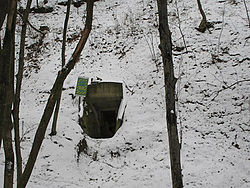| Optymistychna | |
|---|---|
 | |
| Location | near Ukrainian village of Korolivka, Chortkiv Raion, Ternopil Oblast |
| Coordinates | 48°44′33″N 25°59′37″E / 48.74250°N 25.99361°E |
| Length | 230 km (140 mi) [1] |
| Discovery | 1966 |
| Geology | gypsum |
Optymistychna ( Ukrainian: Оптимістична: meaning "optimistic", also known as Peschtschera Optimistitscheskaya) [2] [a] is a gypsum cave located near the Ukrainian village of Korolivka, Chortkiv Raion, Ternopil Oblast. [3] Approximately 264 km (164 mi) [4] of passageways have been mapped within. [1] As a result, it is the longest cave in Europe and the seventh-longest cave in the world, [5] after Mammoth Cave, Sistema Sac Actun, Jewel Cave, Shuanghedong and Sistema Ox Bel Ha. It is also the longest gypsum cave in the world. [1] [6]
History
The cave complex was discovered by the speleologists of the Lviv speleological club "Cyclope" in 1966. It was entirely unknown before then. [7] There have been more than 50 expeditions since then, but exploration has slowed significantly in recent years, and very little surveying is currently being done. [3] The cave is located very close to the Priest's Grotto or Ozerna Cave, the eleventh-longest cave in the world at 130.4 km (81.0 mi), but the two caves have not yet been found to be connected. [1]
In 2008, the cave was recognized as a Natural Wonder of Ukraine. [8]
Geology

The entire cave lies under a 2 km square area in a layer of Neogene period gypsum that is less than 30 metres (98 ft) thick. [7] [9] The passages tend to be fairly small, no more than 3 metres (10 ft) wide and 1.5 metres (5 ft) tall for most, although at intersections they can be up to 10 metres (33 ft) tall. [7] They are often choked with mud. They comprise a dense network on several levels, making Optymistychna known as a "maze cave".
Optymistychna's gypsum bed is topped with a limestone layer, which has seeped through into the cave via erosion and formed into calcite speleothems. [7] At other places, the gypsum has formed crystals, often tinted a multitude of colors by mineral salts. In some areas, large gypsum rosettes have formed, colored black by manganese oxide. [7]
Notes
- ^ This English transliteration was used during the Soviet era but is now deprecated.
See also
References
- ^ a b c d White, William Blaine; Culver, David C. (2012). Encyclopedia of Caves. Academic Press. p. 830. ISBN 9780123838322.
- ^ Herb, Jan Conn (1977). The Jewel Cave Adventure: Fifty Miles of Discovery under South Dakota. p. 230. ISBN 0-914264-20-6.
- ^ a b "Optimistic cave. Speleotourism. Active and extreme tourism. Travel". www.cave-ua.narod.ru. Retrieved 2017-06-28.
- ^ Guden, Bob. "World's Longest Caves". Caver Bob. Retrieved 5 November 2020.
- ^ "OPTYMISTYCHNA IS THE LONGEST CAVE IN UKRAINE - Information Portal Good News". ukrainegoodnews.com. Retrieved 2017-06-28.
- ^ Guden, Bob. "World's Longest Caves". Caver Bob. Retrieved 5 November 2020.
- ^ a b c d e Scheffel, Richard L.; Wernet, Susan J., eds. (1980). Natural Wonders of the World. United States of America: Reader's Digest Association, Inc. pp. 282. ISBN 0-89577-087-3.
- ^ Optimistic Caves Archived 2009-03-24 at the Wayback Machine
- ^ Warren, John K. (2016-05-18). Evaporites: A Geological Compendium. Springer. p. 677. ISBN 9783319135120.
External links
- Official site of Optimistic cave
- Chapter II.9, Gypsum Karst in the Western Ukraine by Alexander Klimchouk article appearing in: International Journal of Speleology, vol. 25, #3-4, 1996, p. 263-278.